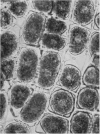Abstract
Experiments were carried out with cortical cells in twig bark of mulberry trees in winter in order to clarify the mechanism of survival at super-low temperatures with rapid cooling and rewarming. Attention was given to the relation between the existence of intracellular ice crystals and survival.
Cortical cells were cooled rapidly by direct immersion into liquid nitrogen or isopentane cooled at various temperatures. After immersion, they were freeze-substituted with absolute ethanol at −78°. They were then embedded, sectioned and examined under the electron microscope for the presence and distribution of cavities left after ice removal.
Cells were found to remain alive and contain no ice cavities when immersed rapidly into isopentane baths kept below −60°. Those cells at intermediate temperatures from −20° to −45°, were almost all destroyed. It was also observed that many ice cavities were contained in the cells immersed rapidly into isopentane baths at −30°. The data seem to indicate that no ice crystals were formed when cooled rapidly by direct immersion into isopentane baths below −60° or into liquid nitrogen.
The tissue sections immersed in liquid nitrogen were rapidly transferred to isopentane baths at temperatures ranging from −70° to −10° before rapid rewarming. There was little damage when samples were held at temperatures below −50° for 10 minutes or below −60° for 16 hours. No cavities were found in these cells. Above −45°, and especially at −30°, however, all cells were completely destroyed even when exposed only for 1 minute. Many ice cavities were observed throughout these cells. The results obtained may be explained in terms of the growth rate of intracellular ice crystals.
Full text
PDF









Images in this article
Selected References
These references are in PubMed. This may not be the complete list of references from this article.
- LUYET B. J., GEHENIO P. M. Effect of the rewarming velocity on the survival of embryonic tissues frozen after treatment in ethylene glycol. Biodynamica. 1954 Dec;7(145-148):213–223. [PubMed] [Google Scholar]
- LUYET B. On various phase transitions occurring in aqueous solution at low temperatures. Ann N Y Acad Sci. 1960 Apr 13;85:549–569. doi: 10.1111/j.1749-6632.1960.tb49982.x. [DOI] [PubMed] [Google Scholar]
- MENZ L. J., LUYET B. J. An electron microscope study of the distribution of ice in single muscle fibers frozen rapidly. Biodynamica. 1961 Aug;8:261–294. [PubMed] [Google Scholar]
- RAPATZ G., NATH J., LUYET B. ELECTRON MICROSCOPE STUDY OF ERYTHROCYTES IN RAPIDLY FROZEN MAMMALIAN BLOOD. Biodynamica. 1963 Oct;9:83–94. [PubMed] [Google Scholar]
- Rapatz G., Luyet B. Effects of cooling rates on the preservation of erythrocytes in frozen blood containing various protective agents. Biodynamica. 1965 Nov;9(191):333–350. [PubMed] [Google Scholar]
- Sakai A. Survival of Plant Tissue at Super-Low Temperature III. Relation between Effective Prefreezing Temperatures and the Degree of Front Hardiness. Plant Physiol. 1965 Sep;40(5):882–887. doi: 10.1104/pp.40.5.882. [DOI] [PMC free article] [PubMed] [Google Scholar]
- Sakai A. Survival of Plant Tissue at Super-Low Temperatures. IV. Cell Survival with Rapid Cooling and Rewarming. Plant Physiol. 1966 Jun;41(6):1050–1054. doi: 10.1104/pp.41.6.1050. [DOI] [PMC free article] [PubMed] [Google Scholar]







